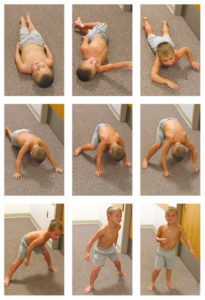Signs of Duchenne
The average age of a Duchenne diagnosis is around 4 years old. Many times there will be delays in early developmental milestones such as sitting, walking, and/or talking. Speech delay and/or the inability to keep up with peers will often be the first signs of the disorder. The symptoms of Becker can begin in childhood, the teenage years, or even later.
If you or any of your healthcare providers (pediatricians, nurse practitioners, family practice providers, etc.) notice one or more of the symptoms listed below, or if you or anyone has concerns regarding delayed development in gross motor, skills fine motor skills or speech, a creatine kinase (CK, sometimes called creatine phosphokinase, or CPK) level should be checked. Learn more about how Duchenne is diagnosed.
Symptoms to look for when Duchenne is suspected include:
- Gower’s Maneuver: needs help getting up from the floor or walks his hands up his legs in order to stand
- Has a hard time lifting their head or has a weak neck
- Is not walking by 15 months
- Has a hard time walking, running, or climbing stairs
- Is not speaking as well as other children their age
- Has calves that look bigger than normal (pseudohypertrophy)
- Walks with legs apart
- Walks on toes and/or waddles
- Walks with chest pointed out (or has a swayback, saddle back, or arched back)
Again, these may be very subtle signs. Having one or several of these symptoms is an indication that further investigation is needed, but does not confirm a diagnosis of Duchenne. Learn how Duchenne is diagnosed.
How do I talk to my doctor about my concerns?
The following tools can help you or your healthcare provider determine whether you should be concerned at this time and help start a conversation with your child’s pediatrician.
- For Parents: The American Academy of Pediatrics has developed the Physical Developmental Delays: What To Look For tool to help parents evaluate their child’s physical development, and possible delays.
- For Medical Providers: ChildMuscleWeakness.org is a site for professionals, helping them to evaluate their patients for delays and possible diagnoses.
American Academy of Pediatrics (AAP) – Physical Developmental Delays: What To Look For tool
Parents are usually the first to recognize that their child’s walking/crawling/running “isn’t quite right” or is “not quite the same as their first child/friend’s child.” Often parents bring these concerns to the attention of their child’s doctor or other healthcare provider, only to find that no one else is not overly concerned.
The American Academy of Pediatrics (AAP) recognizes that parents are the best people to listen to when it comes to developmental concerns. In order to address these concerns, the AAP has developed a tool, with input from Parent Project Muscular Dystrophy, to help parents determine whether they should be concerned at this time and how to follow up on their child’s progress. Please use this tool if you are concerned about your child’s physical developmental delays.
ChildMuscleWeakness.org
Primary care providers (pediatricians, nurse practitioners, family practice providers, etc.) care for hundreds of children and families within their practice, and there are hundreds of different diagnoses that they are presented with every week. In order to help these providers more easily recognize neuromuscular disorders, and to enable a quicker and earlier diagnosis, PPMD worked to develop ChildMuscleWeakness.org, a site developed for professionals to use to learn about the early identification of muscle weakness, view a motor surveillance tool, and download a screening and referral algorithm. Please be sure that your primary care providers are aware of this tool.
How can I be sure if my child has Duchenne?
Having an accurate, timely diagnosis is a critical aspect of care. There are reliable tests to help confirm a the diagnosis of a person with Duchenne. Learn more about how Duchenne is diagnosed.






